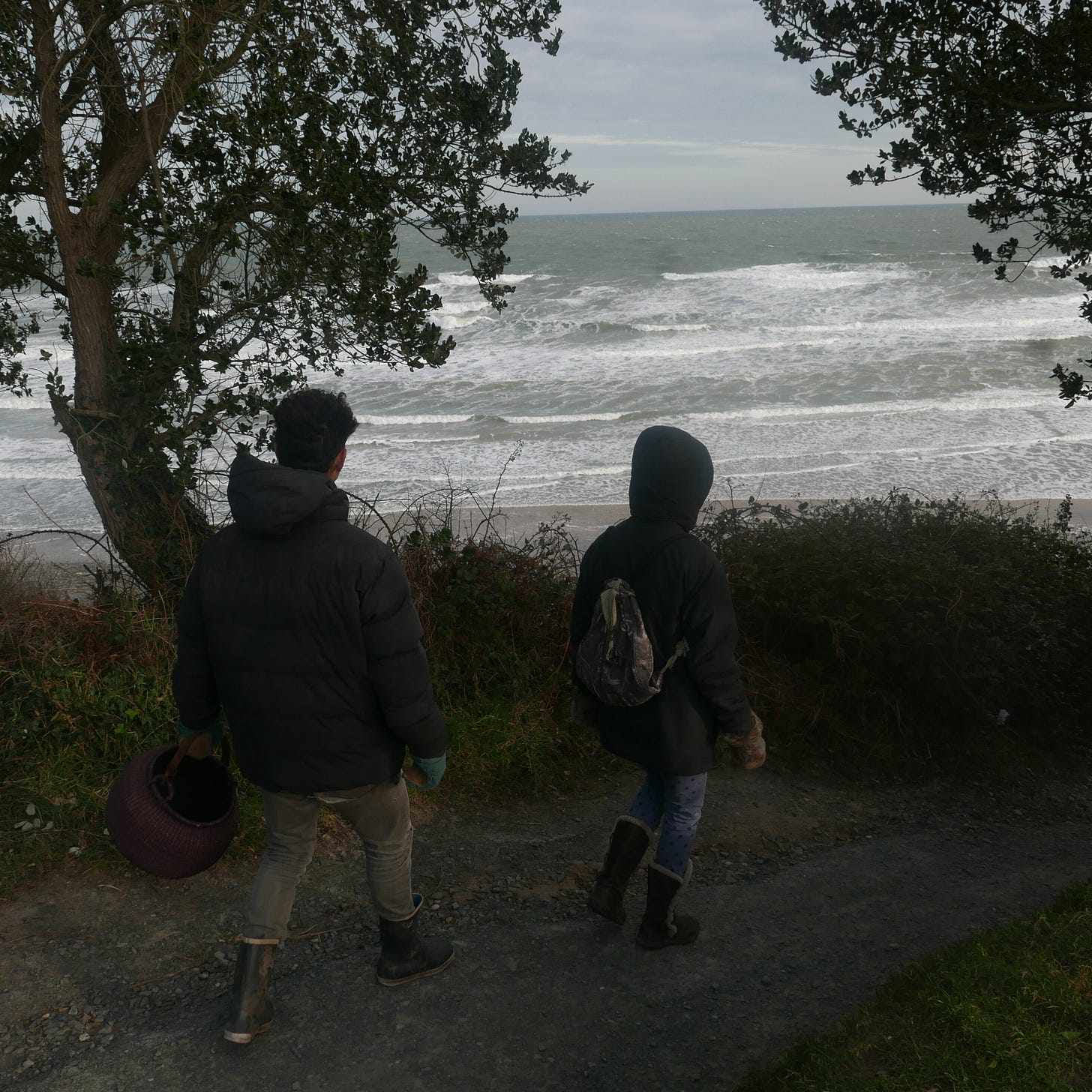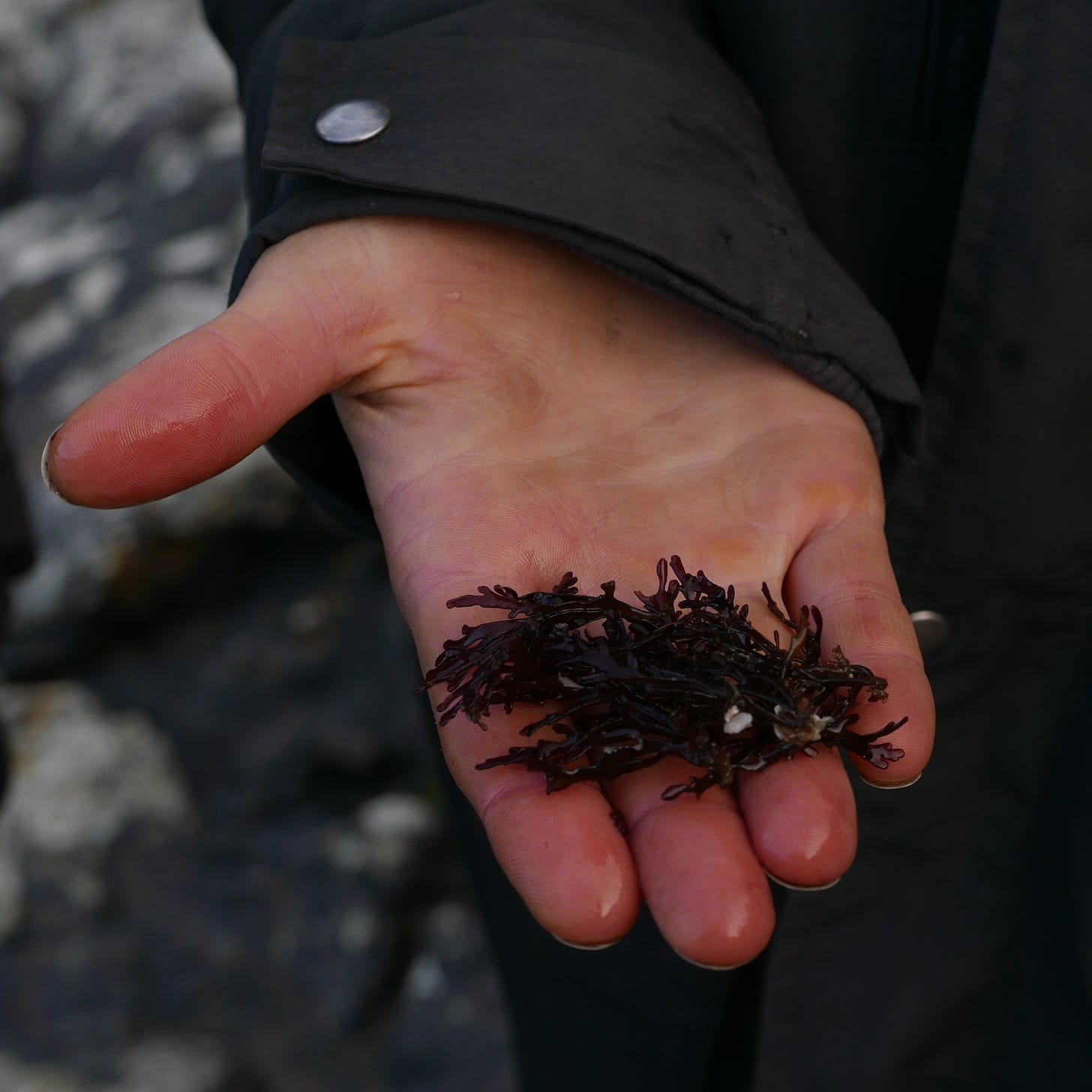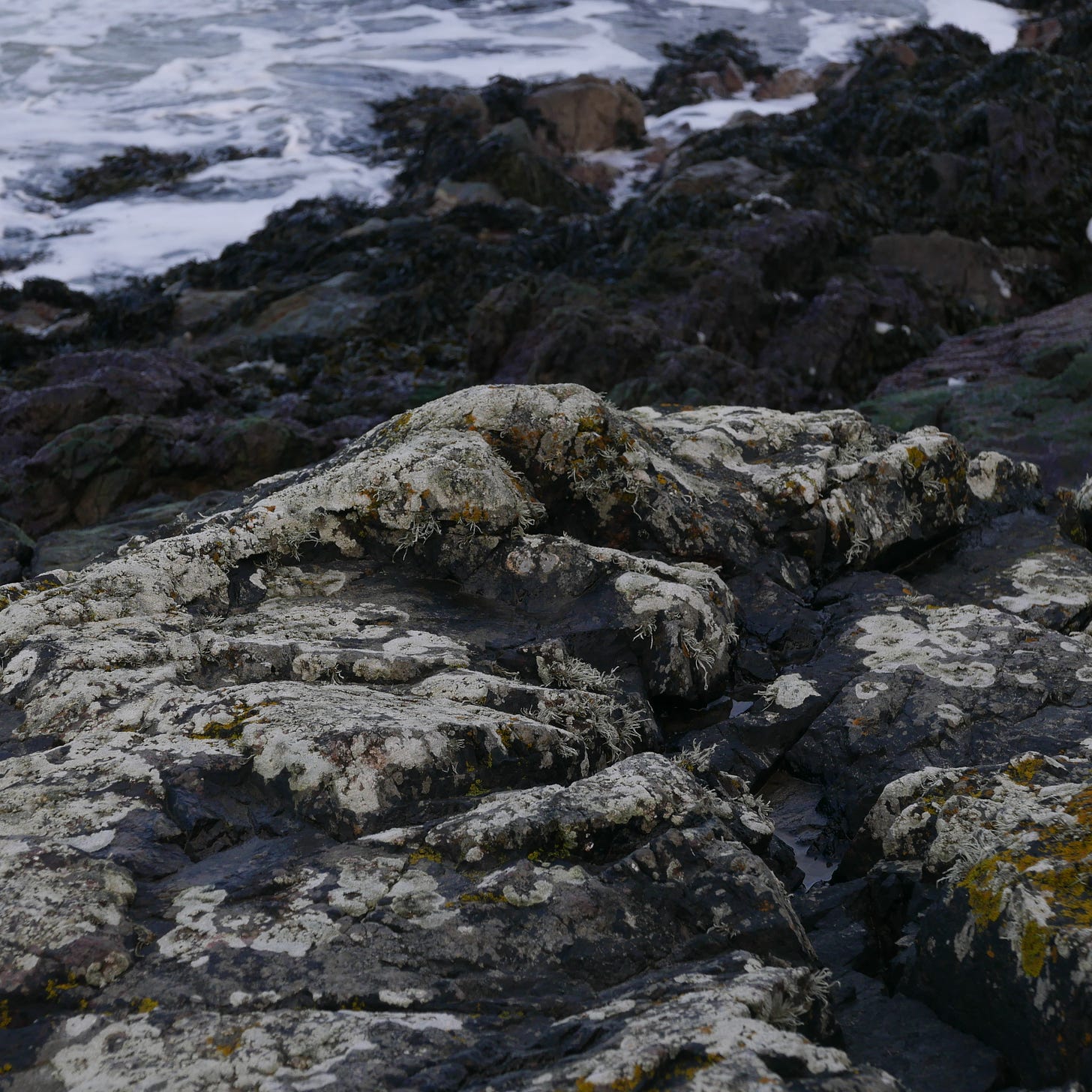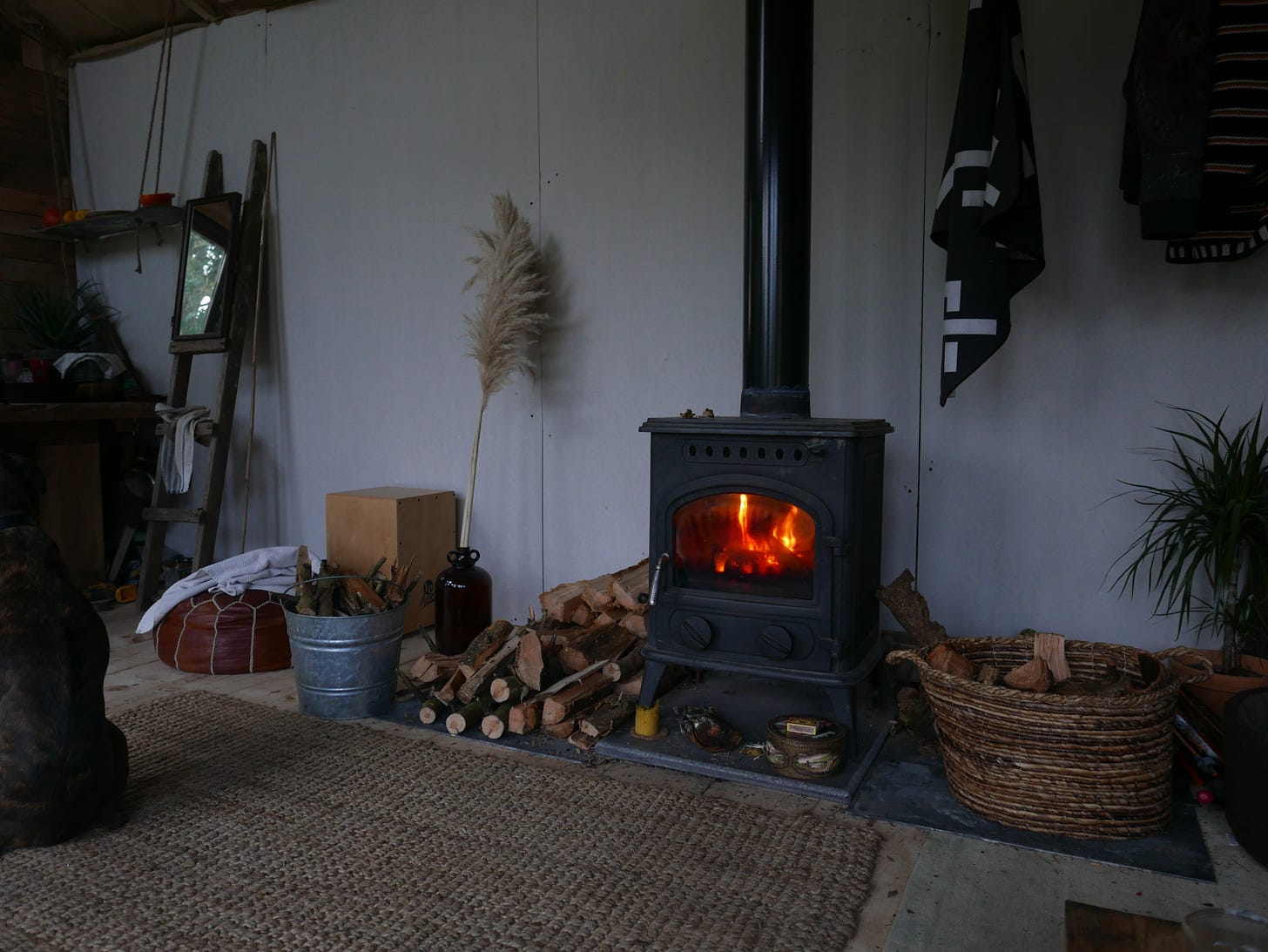Welcome to the Ómós Digest. This newsletter will hopefully bring you on that journey about the food you were looking for, or perhaps never knew existed. It is our quest to expand on what we don’t know and to share with those who care. If you haven’t read Newsletter #1 yet, it can be found here.
This newsletter is brought to you by Cúán Greene, Founder of Ómós.
Dear Readers,
The picture is almost a cliché at this stage. A chef, poised on a rugged coastline, crouched over a basket filled with sea vegetables, contemplatively nibbling algae, professing its deliciousness and resemblance in flavour to the sea. In truth, the chef is most likely experiencing a rather gritty and unpleasurable sensation, laden with sand, an indigestible texture, and a piece stubbornly lodged in the back of their throat. In fact, the romanticised concept of foraging the almost 500 varieties of seaweed in Ireland is more complex than its looks, and seaweed demands more respect than it is given. In order to cook and prepare seaweed in ways that make it both palatable and pleasurable in texture and flavour, it takes skill, education and a great degree of failure. When treated accordingly however, seaweeds can form the basis of an entire approach to cooking, unlocking secret flavours with boundless potential and newfound learnings.
Eager to learn more about the seaweed that grows locally in Ireland, I reached out to Samyel Arnold Keane, a Wicklow based forager, amateur surfer, professional graphic designer, and full time nomad. I first came across Sam when a second cousin told me about him, voicing how it was imperative that we both connect. Upon following his Instagram, it was apparent that Sam was a man of many talents. As I scrolled through his feed, I repeatedly saw beautifully detailed drawings - or scribbles, as he calls them - of foraged ingredients, all depicted in a ‘Roald Dahl’ like style. There were images of him playing the guitar on stage in the most idyllic of settings, as well as beautifully captured wild chanterelle mushrooms, berries and fruits of the ocean.
At our time of meeting, Samyel and his partner Danae, a professional circus performer, were both sat in an old cream coloured Renault 4 van, the type you might see bouncing around a southern French back-road, typically driven by an eccentric winemaker, a pack of OBUT boules (French steel bowls) on the passenger seat, along with a hunting dog, its head pointing out of the window enjoying the breeze. Sam and Danae’s appearance struck me straight away as those of adventurists. Their clothes were worn, ripped in places, but they carried themselves in a way that seemed natural and justified. Their outdoor lifestyle meant there was a year long glow to their skin, radiating in a way that showed how living was about balance and wellbeing for them - a lifetime pursuit for many of us. Over the course of this day, I soon became aware of how true that sentiment really was.
It turned out, similarly to myself, although born in South Dublin, Sam grew up in France, and this Renault evoked the same memories to him as they did to me. We instantly connected, exchanging French courtesies, while walking down a long sand road, in the direction of the coast line. Magheramore beach possesses the rawness and energy synonymous with the Irish coastline, while mysteriously home to exotic foliage such as palm trees, which surprisingly thrive due to strong ocean currents. Although perfect for any chef in search of the aforementioned wanderlust photoshoot, this was a place where Sam and Danae surfed, as well as a bountiful location for foraging seaweed, a commodity that formed an important part of their diet. Eager to show my stripes in the company of veterans, and that I too foraged frequently, I came equipped with my foraging knife and basket, ready for what was ahead. However, in one almighty novice move, I had inexcusably forgotten my boots, exposing my inner city genetic code. As we approached the beach, Sam one-upped me again. On top of his encyclopedic knowledge of wild food and flawless foraging attire and etiquette, he explained that during his time living in Australia he had learnt to practice and rely on the art of skipping. Unaware of the term, Sam explained that this was less of the kind implemented by Floyd Mayweather and more of that carried out by Dumpster Divers. It is for no better term, shopping for waste.
Dive right in
In some ways dumpster diving can be perceived as invasive, unsanitary and potentially harmful to the proprietor's privacy and/or to the diver’s health. Forms of dumpster diving exist as an act of crime, where the aim is to unearth and uncover useful information that may help an individual get access to a particular network. This is not the case with Sam and Danae. Their concept and search for treasure in another person's trash, relates to the thousands of kilograms worth of faultless food and product wasted annually by supermarkets. To them, the products they resource are completely salvageable and support their way of living.
I like to think I am open minded, but I have been trained in an environment where the preparation of food requires a sanitary mindset. Although I embody a natural approach when it comes to food, with little intervention and maximum respect, I acknowledge improper treatment of food can cause harm, and for this reason, I have a very serious outlook on food safety. This was my first time meeting people who practiced skipping and slightly taken aback, I couldn't help but wonder what dinner would constitute. My mind unavoidably imagined a rancid fish and bowl full of decaying commodities lying before me. But upon speaking to my newfound friends, it was remarkable to get their insight. They too shared this outlook, that safety was always the highest priority, and if this wasn't the case, the product wasn’t skipped. Perishable food was always checked with extreme care. While a large majority of their produce was free, either skipped or foraged, more perishable produce like meat and fish were most often purchased at markets. Although as a principle, Sam and Danae avoid proteins whilst skipping, during one excursion and at a newly found supermarket, the sight of 10 freshly disposed of T- Bone steaks, all in-date and in perfect condition, was too great to avoid. The meat was fridge cold and the only identifiable imperfection was in the label, which had been torn. Despite their initial reservation, the level of waste and disrespect almost seemed too disgusting to ignore, and with that Sam prepared a sumptuous carnivore feast that evening.
Just like other mammals, years of searching for wild food meant they had developed an acute sense of smell and peripheral vision, telling me that they trained themselves to use their nose in a way that it is so rarely used today, aiding them in identifying what is safe and what is not. It was in moments like these that we connected, as I easily could relate to my own experiences. The ingredients I ferment rely on the controlled decomposition of cells, converting them to healthy bacterias. With the correct procedures put in place, ferments can be wonderful, and like seaweeds can transform dishes. Sometimes though, they don't pan out. One of the primary ways to know whether a product is palatable or not, and to save yourself from an extremely unpleasurable experience, is to make use of the snout, giving food a sniff. Important that.
Sam tells me that over the festive periods he got to know one of the shopkeepers, who would in an act of kindness, intentionally leave the latch of the waste unit unlocked. The employee informed them that following any festive season, hundreds of kilos of seasonal produce would be discarded, meaning each dumpster was filled to the brim with Christmas cakes, whole baked hams, vacuum packed chestnuts or Easter eggs by the truckload. Similarly, any products containing outer packaging were up for grabs. Shocked by their findings, the skippers decided to alter their skipping methods, choosing to shop by day rather than night in an effort to better normalise the activity.
There was something both remarkably festive and unfestive about the turn of events.
Dinner unfolds
As we walked over slippery rocks, Sam stopped intermittently, lifting up more common seaweeds to unearth the varieties he was most in search of: sea lettuce, channel wrack, carrageen and pepper dulse amongst many more. It was wonderful to experience Sam’s knowledge of seaweed, but also his passion and enthusiasm for an often overlooked native ingredient. The small landmass of rocks were home to over 50 species of edible seaweeds, of which Sam had both the Irish term and English term for. As we roamed the rocks collecting the basis for our supper, out of his pocket, Sam dislodged a Sea Booklet he had curated, inspired by Magheramore beach. Designed using a single A4 card, the booklet was separated into 16 connected square pages, all separated by folds. Each page contained varieties of the hand-sketched native seaweeds found on the beach. When fully folded in a closed position, the seaweeds visible were those that could be found when the tide was in. Unfolding the book halfway revealed algae available at half tide. Fully unraveled, the booklet displayed the shore's entire portfolio of seaweeds.
As dusk approached and we made our way back in the direction of the hut, turning our attention to dinner, I knew that this was only the beginning of a very special encounter...
This is the end of Part 1.
Part 2 (for paid subscribers only) will be available next week and will explore in greater depth the uses of seaweed. We’ll take a look at the various species that exist and where you can collect them. For inspiration on how to use your foraged finds, we’ll provide practical culinary uses of seaweed, with the mindset of always encouraging deliciousness. On the story side of things, we’ll revisit what exactly was on the menu that night back at Sam and Danae’s hut, and how meeting incredible people like them can spark a relationship to last a lifetime. Click the big red button below to upgrade for this newsletter.











Ómós Digest # 13: Dive to Dine (part 1)